Sergio broke away from paradigms by inventing a language of his own in search of the Brazilian identity.
Sergio broke away from paradigms by inventing a language of his own in search of the Brazilian identity
Sergio Rodrigues left us in September 2014, when revisiting his life and career. Always with great humor and precision, he chronicled much of his childhood and adolescence, his college days, and the opening of OCA, a store he created and that heralded a new phase in the production of Brazilian furniture. Sergio is one of those Brazilians who leave behind a large void in the country’s life when they go. He is an icon, not only of design and architecture, rather of the Brazilian culture. His deliberate, relentless pursuit of modern Brazilian furniture was one of his great contributions to the story of creativity in Brazil. The Delta Larousse Encyclopedia defines him as “the creator of the Brazilian furniture.”
Born in 1927, in Rio de Janeiro, he graduated as an architect in 1952 and went out in a “frantic search,” as he himself put it, for a type of design that could represent the spirit “of our people.” In architecture, his designs were made in order for “life to happen in there.” Sergio broke away from paradigms to invent his own language in search of the Brazilian identity and harmoniously integrated the three areas in which he militated: architecture, design, and drawing.
His creations came at a time when Brazil was investing in a new federal capital, and the Brazilian people were breathing an atmosphere of invention and of Brazilianness in fine arts, music – with Bossa Nova – and architecture, with the construction of Brasília. Sergio sensed that modern Brazilian architecture lacked contemporary furniture to keep up with this. Sergio’s creations, aimed to make modern, comfortable furniture suited for the Brazilian tropical climate, making great use of wood and leather, soon led him to the new capital: His furniture was ordered in large scale and taken to Brasília.
An expert designer, a talent inherited from his father Roberto Rodrigues, Sergio collected not only drawings of his projects, but also humorous illustrations of his furniture, of everyday scenes and of himself. The words of the designer Fernando Mendes de Almeida about his teacher, friend and cousin, highlight the importance of the creator: “Sergio Rodrigues’ dimensions as an artist and public figure become eternal and blend in with our life history and with the history of the nation itself. Few Brazilian artists defended our culture, our way of life, and the way we are for so long and with such determination. Few designers had such a long productive life.”
To the journalist and design expert Adélia Borges, author of Sergio Rodrigues, part of Editora Viana & Mosley’s Arquitetura e Design collection, nationality defines Sergio. “He presents himself with a much more personal vision, one which comes from our Iberian tradition of more robust, heavier furniture. And he did this while Joaquim Tenreiro used to say that Brazilian furniture should be formally light. This is what distinguishes Sergio.”
By adopting a Brazilian language, Sergio also drew inspiration in the appreciation of Brazilian materials, especially wood and leather. An architect, product designer, interior designer, set designer, dresser, decorator and lecturer – in all his multiplicity, Sergio, over and above his explicit Brazilianness, imbued his creations with the spirit of Rio, ever since a time when the city of Rio de Janeiro boiled with modernization, and Brazil turned to the pursuit of its national identity, especially in the arts.
Sergio’s contribution to the gestation of the truly modern Brazilian furniture is undeniable. Obstinate, he never stopped creating and devoted his creative energy to design throughout his life. He was always in a “permanent state of creativity and production, despite the several adversities he faced along the way,” says the article devoted to him posted on the Casa Museu do Objeto website.
In just over a half-century of work, Sergio created some 1,200 different models of furniture. “His furniture is based on our deep cultural roots, but is not limited to them. He built a very particular language in which he recreates the robust furniture of the Iberian tradition, but within a modern syntax. In addition, he was instrumental in helping add value to interior design and, by doing so, taking design to the field of culture,” says the article.
And also: “Sergio knew how to overcome difficulties with persistence, work capacity, tenacity, energy, and his unlimited talent. He was a pioneer not only of design in Brazil, but also of design from Brazil. A design that believes in the country’s own values and seeks to be the expression, in the form, of these values.”
To Adélia Borges, who says Sergio’s legacy is superlative, “It’s a privilege to have a person of his dimensions in the Brazilian design scene. He transcends his area of operation and becomes significant for society in general.”
Fernando Mendes de Almeida believes that another one of Sergio’s great legacies is the message he left of the example of his own life and of his entire professional career. “The great life lesson he leaves us is to always have done what he liked and wanted to do, with enthusiasm, courage and daringness. It is as if he always said to us: Do it with love, passion, surrender to what you are doing. I am a great admirer of his strength and joy.”
Sergio’s place in this scenario is unique. His Brazilianness was always in his ability to absorb the life around him and observe the world in which he lived and of which he was a full part. Nothing better to understand this passion for all things Brazilian than an excerpt from an interview he gave in 1985 to Casa e Jardim magazine, which was republished in September 2014, shortly after his death:
He said that in order to create Brazilian furniture it sufficed to imagine a few scenes:
“That late afternoon charm at a farm balcony, after a summer downpour, with the smell of damp earth in the air, a ripe mango, a certain corral touch, with a fresh cup of coffee and toasty warm corn scones.
or
Dawn on a white sand beach, the calm sea, a scenery with the marked horizon of spring, where the cool breeze and the sea air mix.
or
A cold night in the mountains, with shadows disturbed only by the excitement of the fire in the fireplace burning pine-tree heart, a draft filling the air with the smell of lavender, mold, smoke from a pipe burning good tobacco, perhaps a little onion soup.
or
Perhaps afternoon tea, next to a small, well-kept inside courtyard, peanut brittle flooring covered with small plant vases and grassland flowers, only dark wooden pergola from which tree ferns with Benghal dayflowers and ferns planted in them hang. “
It is, in fact, design in his mind and Brazil at the tip of the pencil. The Brazil he kept in his heart with fervor.
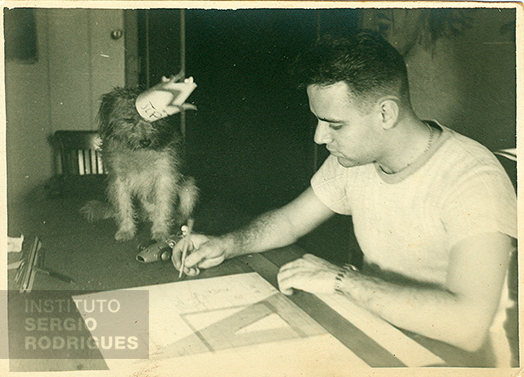
Sergio Rodrigues at age 20, making a technical drawing next to his dog Pipoca, at Castelinho, at Praia do Flamengo, No. 72 - Rio de Janeiro, in 1947.
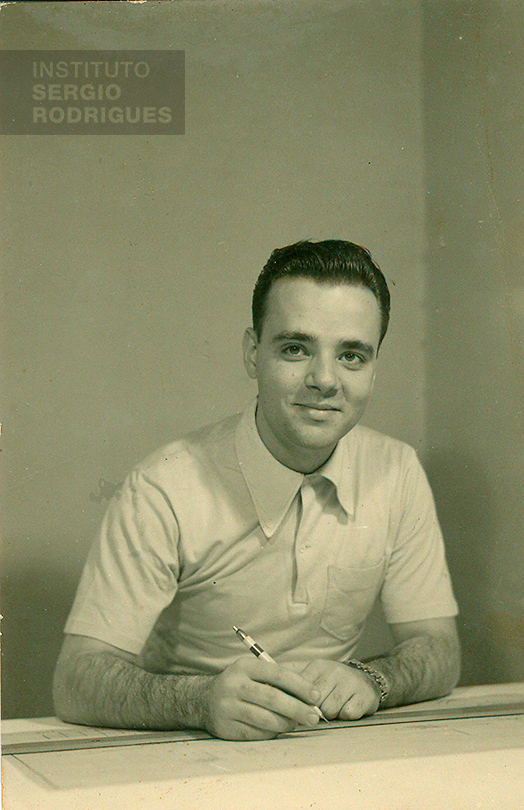
Sergio Rodrigues at age 23, period when he studied at the University of Brazil's National School of Architecture (today the Federal University of Rio de Janeiro's College of Architecture and Urban Planning - FAU/UFRJ), Rio de Janeiro, 1950.
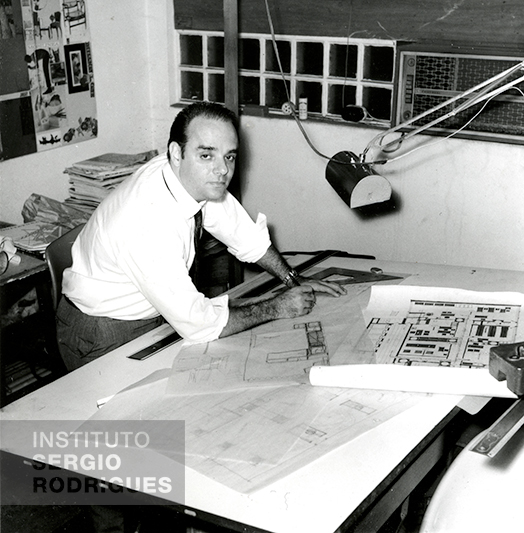
Sergio Rodrigues, at age 39, in his office at the Oca store, located at Rua Jangadeiros No. 14 - store c, Ipanema - Rio de Janeiro, in 1966.
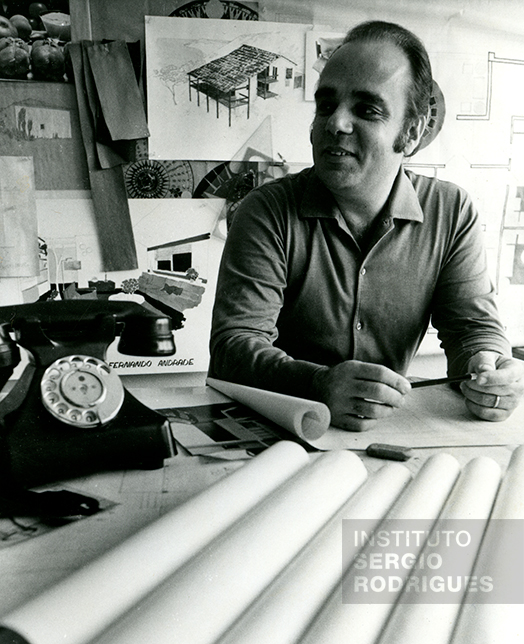
Sergio Rodrigues, at approximately age 43, in his office located at Rua No. 14 - store c, Ipanema - Rio de Janeiro, in the early 1970s.
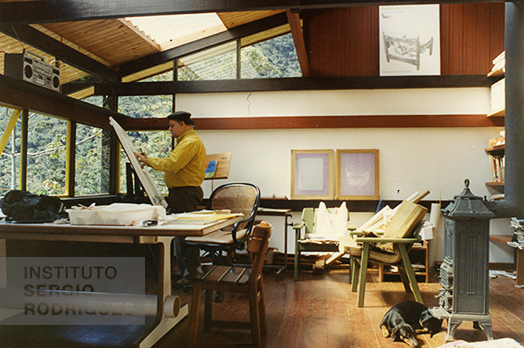
Sergio Rodrigues in his studio at Xikilin, a house designed using the industrialized architecture SR2 System made out of wood, Rocio - Petrópolis, 1983.
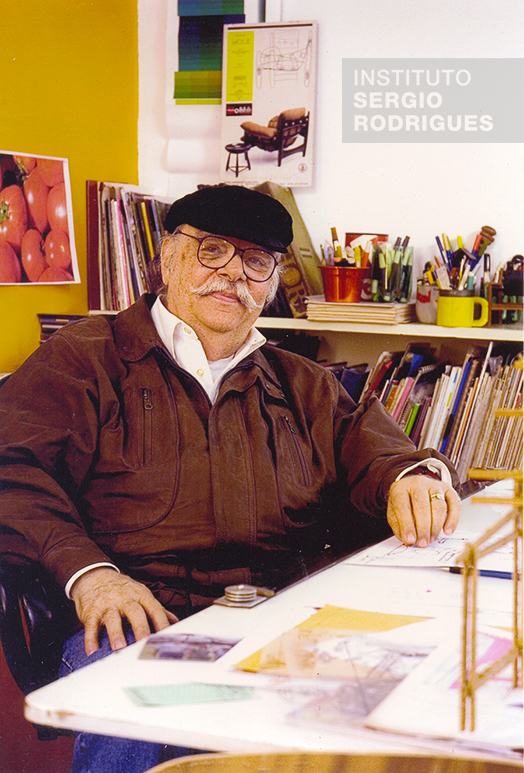
Sergio Rodrigues in his creation studio, in Botafogo, Rio de Janeiro, in the 1990s.
